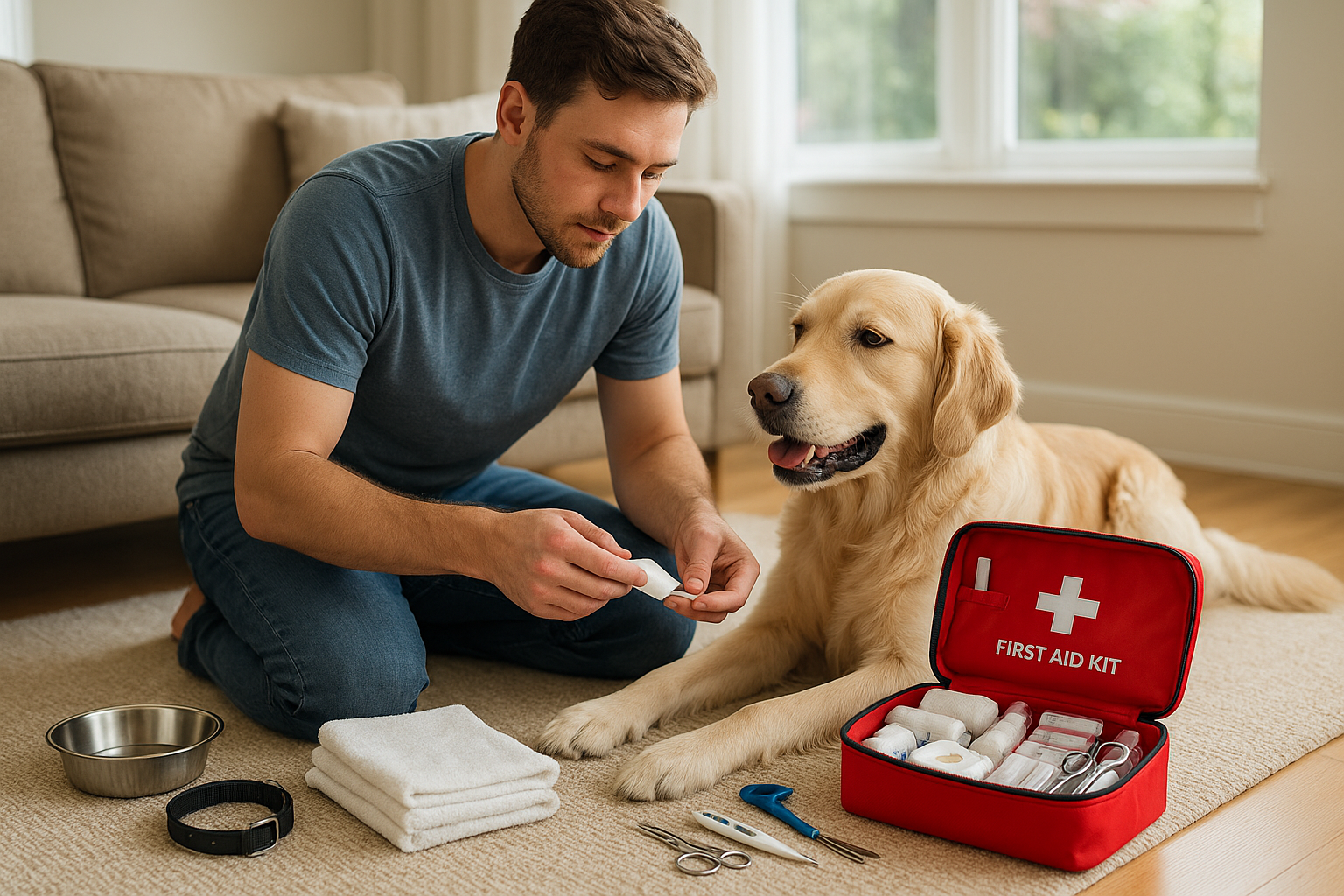😔 This, however, should not be the case. Understanding the basics of dog first aid is not only a vital part of responsible pet ownership, but it can also mean the difference between life and death for your canine companion. 🐶
Welcome to “Pawsitively Prepared: Essential Dog First Aid Tips for Keeping Your Furry Friend Safe and Healthy”. In this comprehensive guide, we will dive deep into the critical aspects of dog first aid that every pet parent should know. We will explore actionable steps you can take to ensure your furry friend stays safe, healthy, and, most importantly, happy. 🐕🦺
It’s no secret that emergencies and accidents can happen at any time. Whether it’s a minor cut, burn, or something more serious like choking, immediate first aid can significantly impact your dog’s health. However, it’s not just about reacting; it’s about being prepared. 🎒
Let’s be honest, no pet parent wants to think about their beloved furry friend getting hurt. Yet, it’s essential to acknowledge that being equipped with the right knowledge and tools can make a world of difference when the unthinkable happens. 🚑
What to Expect in This Guide
We will kick things off by discussing why dog first aid is so important. This section will provide an overview of the benefits of being prepared, including how it can help prevent small issues from escalating into serious health problems. 🏥
Next, we will delve into the essential elements of a dog first aid kit. We’ll identify the must-have items you should always have on hand, as well as provide some tips on how to effectively use them. From bandages to antiseptics, thermometers to tweezers, you’ll be guided through the process of assembling a comprehensive first aid kit that caters to your dog’s unique needs. 🩹
Then, we will explore common dog emergencies and how to handle them. We’ll cover scenarios like poisoning, heatstroke, fractures, and more, equipping you with the know-how to respond effectively when disaster strikes. 🚨
Finally, we’ll look at the importance of aftercare following a medical emergency. Proper care post-incident can be just as vital as the immediate response, and we’ll explain why. You’ll learn how to monitor your pet’s recovery and when to seek professional help, ensuring your dog gets back on its paws as soon as possible. 🐾
Regardless of your level of experience as a pet parent, this guide will serve as a comprehensive resource to navigate the intricacies of dog first aid. Our furry companions depend on us for their well-being, and it’s our duty to ensure they receive the best care possible, especially in emergency situations. So, let’s get started! 💪
🐾 The Pawsitive Impact of First Aid on Your Dog’s Well-being
Being a pet parent is more than just cuddling and playing fetch. It also involves ensuring the safety and health of your furry friend. One critical skill every dog owner should have is knowledge of first aid procedures. Just as humans sometimes require immediate medical attention, dogs too can encounter emergencies requiring prompt action. This not only improves their chances of survival but also enhances their overall well-being.
First aid for dogs is not meant to replace veterinary care. Instead, it acts as immediate assistance until professional medical help is accessible. It’s about stabilizing your pet and preventing further injury. In some cases, your quick response could save your pet’s life. The following are essential first aid tips that every dog owner should know.
Remember, always consult with your vet after administering first aid to ensure your pet receives the necessary care and treatment. Dogs can’t tell us how they’re feeling, so a vet’s expertise is crucial in diagnosing and treating injuries or illnesses.
👨⚕️ The Basics: Preparing a Dog First Aid Kit
Just as we have first aid kits for ourselves and our families, it’s equally important to have one for our furry friends. A well-stocked first aid kit can be a lifesaver in an emergency. It allows you to respond swiftly and effectively, preventing complications and further injury.
A basic dog first aid kit should include items such as bandages, gauze pads, adhesive tape, antiseptic wipes, a digital thermometer, tweezers, and a blanket. Some pet parents also include a muzzle, as even the friendliest dog can bite when in pain. Always keep your first aid kit in a convenient and accessible place. Remember, emergencies can occur anytime, so it’s essential to be prepared.
Aside from the physical items, your kit should also contain important information. This includes your vet’s contact details, an emergency vet clinic’s number, and poison control. Additionally, keep a copy of your pet’s vaccination records and any known allergies. These can be invaluable in a critical situation.
✔️ Table: Basic Dog First Aid Kit
| Item | Use |
|---|---|
| Bandages | To control bleeding and protect wounds |
| Gauze pads | For covering and cleaning wounds |
| Adhesive tape | To secure bandages and gauze |
| Antiseptic wipes | To clean wounds and prevent infection |
| Digital thermometer | To check your dog’s temperature |
| Tweezers | To remove foreign objects |
| Blanket | To keep your pet warm and comfortable |
| Muzzle | To prevent bites when your pet is in pain |
For a more detailed look into what to include in your dog’s first aid kit, consider watching the video titled “How to Make a Dog First Aid Kit” by PetMD on YouTube.
🔬 Understanding Common Dog Injuries and Illnesses
Dogs, just like humans, can suffer from a variety of injuries and illnesses. Some of these include cuts and wounds, choking, poisoning, heatstroke, and seizures. As a pet parent, it’s essential to understand these common conditions and how to provide first aid.
Cuts and wounds, for example, can occur from a variety of sources such as sharp objects or rough play. The first step is to clean the wound with water and apply an antiseptic. Next, apply a clean bandage or gauze and secure it with adhesive tape. In the case of deep wounds, it’s essential to seek immediate veterinary attention.
For choking, your immediate action can save your dog’s life. Look into your pet’s mouth and remove any visible objects. Be careful not to push the object further down. If you can’t remove it, perform the canine Heimlich maneuver. However, it’s crucial to learn this technique from a professional to prevent injury.
The importance of understanding these common conditions cannot be overstated. By knowing how to respond, you can provide immediate help to your pet, preventing further injury and possibly saving their life.
For further understanding of common dog injuries and illnesses, and how to administer first aid, watch the video titled “Dog First Aid: How to Treat Various Injuries and Illnesses” by Best Friends Animal Society on YouTube.
📚 The Importance of Learning Canine CPR
Canine CPR, or cardiopulmonary resuscitation, is a lifesaving technique used when a dog’s heart has stopped beating. Just as in humans, it involves chest compressions and rescue breaths to restore circulation and oxygen flow.
While it’s a skill we hope never to use, knowing canine CPR is essential. It can make a significant difference in an emergency situation, potentially saving your dog’s life. However, it’s important to note that canine CPR should be performed by someone trained in the procedure to prevent further injury.
If your pet is unresponsive, place them on their right side and begin chest compressions. The rate should be around 100-120 compressions per minute. After every 30 compressions, give two rescue breaths by closing your pet’s mouth and blowing into their nose. Repeat this cycle until help arrives. Remember, it’s essential to seek veterinary care as soon as possible.
For a visual guide on how to perform canine CPR, watch the video “How to Perform CPR on a Dog” by Vet Ranch on YouTube. However, it’s strongly recommended to attend a practical training session under the guidance of a professional.
🏥 Knowing When to Visit the Vet
While first aid is a crucial component in caring for your dog, it’s equally important to know when to seek professional help. Remember, first aid is not a substitute for veterinary care. Instead, it serves as an immediate response to stabilize your pet and prevent further injury.
Signs that your pet needs immediate veterinary attention include severe bleeding, difficulty breathing, loss of consciousness, seizures, and severe vomiting or diarrhea. Other signs include suspected broken bones, inability to walk, and ingestion of harmful substances. In such cases, immediate veterinary attention is necessary.
Regular veterinary check-ups are also essential to ensure your pet’s health. These routine visits can help detect potential health issues before they become serious. They also provide an opportunity for your vet to advise on preventative measures, enhancing your pet’s overall well-being.
For more information on when to seek veterinary care for your pet, consider watching the video “When to Take Your Pet to the Vet” by Dr. Uri Burstyn, the Helpful Vancouver Vet on YouTube.

Conclusion
In conclusion, we have traversed an extensive journey into the realm of technology and engineering, shedding light on some of the most intricate aspects of IT and software engineering. We have explored in depth, the inherent complexities of these fields and how they are constantly evolving in response to the dynamic digital era. The value and importance of understanding these principles, both theoretically and practically, cannot be overstated.
As we reviewed the concept of software development, its different approaches and techniques, we were able to comprehend the imperative nature of creating a well-structured and robust software architecture. It was emphasized that the quality of software architecture has a direct impact on the functionality, adaptability, and overall success of the software.
We then delved into the field of IT and explored its various components such as networks, databases, and cybersecurity. A special focus was placed on the importance of IT in businesses and how it is becoming the backbone of many modern organizations. 🖥️🌐
We also discussed the role of big data and AI, two of the most disruptive technologies of the 21st century. The potential of these technologies in transforming industries and societies is immense and understanding their operations and applications is essential for any tech enthusiast or professional. 🤖📊
Finally, we examined the significance of user experience and interface design in today’s digital age. The user-centric approach is no longer a luxury but a necessity for any digital product aiming to attain market success.👥🎨
The importance of the topics addressed in this article extends beyond the scope of this discussion. They have profound implications for not just tech professionals, but for anyone who wishes to navigate the digital world with ease and competence.
Remember, the technical world is a constantly changing landscape and to stay afloat, one must be willing to learn and adapt. 💡📚
I hope you found this piece insightful and inspiring. Feel free to share your thoughts, experiences or queries in the comment section. Don’t hesitate to share this article with your colleagues or anyone who might find this information useful. I encourage you to further explore these concepts, apply them in your work or studies and witness the impact it can have on your understanding and performance.
You can further enhance your knowledge about these topics by checking out these resources:
– W3Schools: A comprehensive learning platform for web development.
– Mozilla Developer Network: A vast repository of resources for developers.
– Tutorials Point: A platform offering free tutorials on a range of IT and software engineering topics.
Remember, the journey of learning is a continuous process, so keep exploring, keep learning, and keep growing.
Signing off,
Rodrigo Almeida ✌️💼🚀



